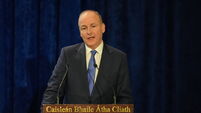Thousands watch planetary spectacle
Thousands of people all across Ireland were left star-struck today after witnessing an extremely rare event.
David Moore of Astronomy Ireland said billions of people across three-quarters of the world’s surface were able to view the planet Venus cross in front of the Sun for the first time.
“The last one was in 1882 that is 122 years ago. Since there is nobody 122-years-old alive today, that means no-one alive had ever seen a transition until this morning,” Mr Moore said.
“We are up there in the league table of being some of the first people in the world alive to have seen a Venus transit, which feels very good.”
A steady stream of people continued to gather at Dublin’s Phoenix Park, which was one of 10 sites across Ireland equipped by the astronomy club members to enable people to safely view only the sixth crossing ever recorded in history.
Niall Conran, 10, whose mother Eileen brought him along, said: “I really wanted to see it, as everyone is talking about it.
“But it was very small.”
Mr Moore said the planet Venus appeared very small in relation to the Sun, simply like a black spot moving slowly across the bright surface.
Astronomy lovers, who had been counting down the days to the transition, had one main worry that nature might interfere.
“The day is finally here and the big worry over the weekend was that it might not be clear to see it,” Mr Moore said.
“But we were here at 6.19 this morning when it began and it clouded in just at 6.19. But a few minutes later it cleared up and we have been watching Venus crossing the disk of the Sun since.
“And we’ll spend the whole six hours here,” the chairman of the 14-year-old club, Astronomy Ireland, said.
Many people from around Dublin brought their children along to the Phoenix Park for a peek into the world of science while others travelled from further afield.
One man admitted he drove up from Skibbereen, Co Cork, while another had clocked up considerably more mileage when he flew in from Los Angeles.
Victor Jorge Lopez from California, who had combined this with a trip to see next week’s James Joyce festival, said: “No-one there can see it. Absolutely nobody alive today has ever seen it until today.
“I’m absolutely delighted I came.”
Belinda Walsh, brought her three boys, six-year-old Cian, Ronan, 3, and six-week-old Conor along from Maynooth in Dublin, to try and catch a glimpse through the eight huge telescopes covered with protective filters.
“The older one was six-and-a-half, he was really interested in it,” she said.
“He got interested in science just by reading books on science and on the stars and the planets.”
Taxi-driver Paddy McGuinness, who took a short pit-stop, said: “I thought it was very interesting well worth a look. Just to be here was a good impression, the people starting to talk about astronomy, you could actually get more involved just by being here.”
Mr Moore said in the past the event was a minefield of scientific information.
As scientists first used the transits to calculate the distance to the planet and use it to map the size of the universe.
“It was groundbreaking stuff back then. Once they tied down the distance to Venus that was it the whole universe fell into place,” Mr Moore said.
The crossings occur in pairs, which are eight years apart, with each pair 120 years apart.
“In 1769 Captain Cook was sent to Tahiti to observe the Venus transit.
“That was the reason he was sent there at that time. After that transit he went on to discover New Zealand and Australia and declare it for the British Empire, so Australia owes its British history to a transit of Venus back in 1769,” Mr Moore said.
Astronomy Ireland has already mapped a further itinerary of science spectacles for the summer.
They include the international space station crossing the sky and an event in the Wicklow Mountains to mark a huge shooting star shower in August.












